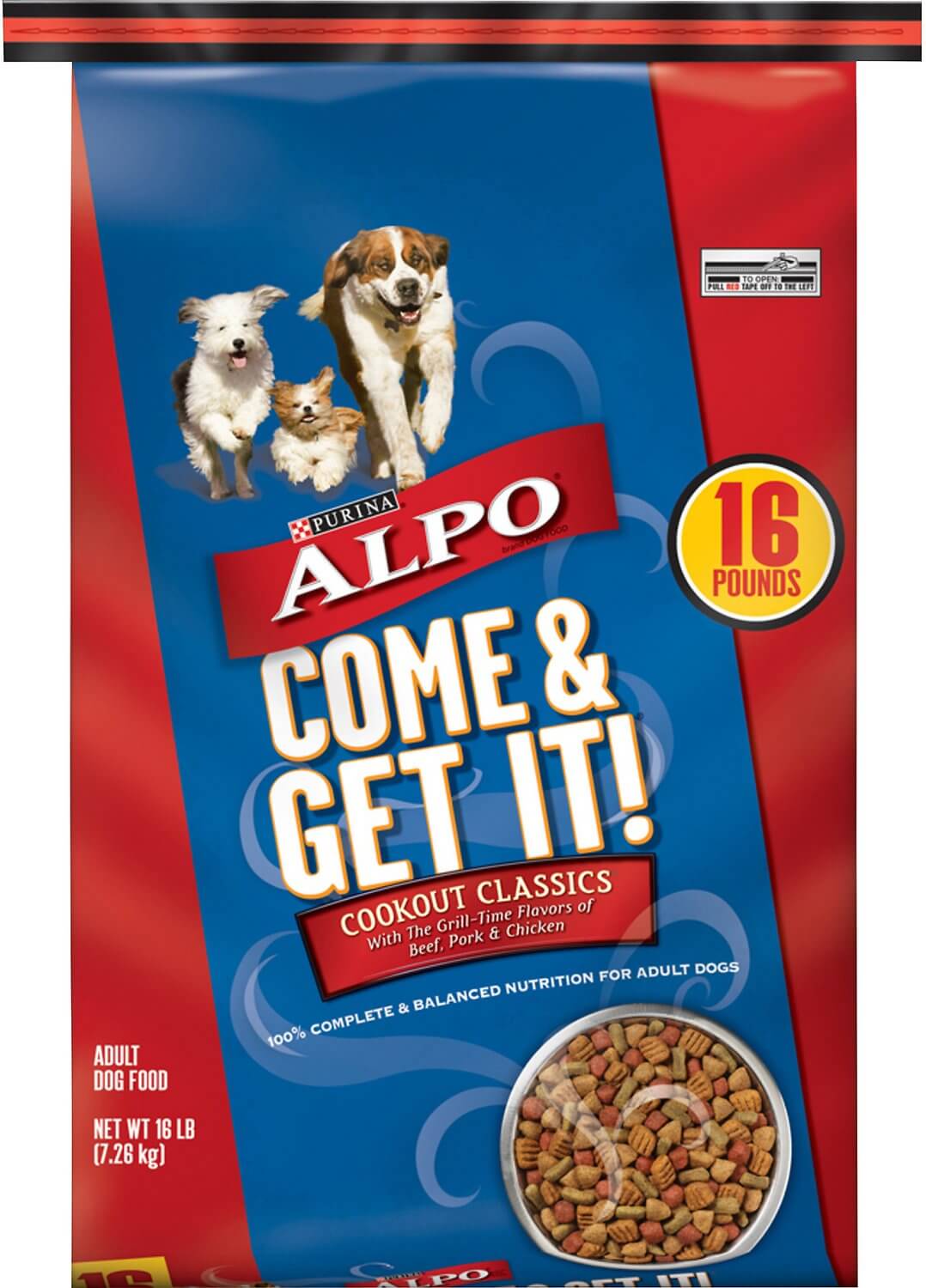
DogFoodAdvisor is reader supported See how
All reviews are 100% impartial but if you buy using links on this page, we may earn a referral fee.
Which Alpo Recipes Get Our Best Ratings?
Alpo Dog Food receives the Advisor’s lowest rating of 1 star.
The Alpo product line includes the 2 dry dog foods listed below.
Each recipe includes its AAFCO nutrient profile when available… Growth (puppy), Maintenance (adult), All Life Stages, Supplemental or Unspecified.
| Product | Rating | AAFCO |
|---|---|---|
| Alpo Prime Cuts Savory Beef Flavor | 1 | M |
| Alpo Come and Get It Cookout Classics | 1 | M |
Recipe and Label Analysis
Alpo Come and Get It Cookout Classics was selected to represent both products in the line for detailed recipe and nutrient analysis.
Label and nutrient data below are calculated using dry matter basis.
Alpo Come and Get It Cookout Classics
Estimated Dry Matter Nutrient Content
Protein
Fat
CarbsCarbohydrates
Ground yellow corn, corn germ meal, beef and bone meal, soybean meal, beef fat preserved with mixed-tocopherols, pork and bone meal, egg and chicken flavor, natural flavor, corn gluten meal, salt, potassium chloride, choline chloride, minerals [zinc sulfate, ferrous sulfate, manganese sulfate, copper sulfate, calcium iodate], sodium selenite, natural grill flavor, vitamins [vitamin E supplement, niacin (vitamin B-3), vitamin A supplement, calcium pantothenate (vitamin B-5), pyridoxine hydrochloride (vitamin B-6), vitamin B-12 supplement, thiamine mononitrate (vitamin B-1), vitamin D-3 supplement, riboflavin supplement (vitamin B-2), menadione sodium bisulfite complex (vitamin K), folic acid (vitamin B-9), biotin (vitamin B-7)], dl-methionine, l-lysine monohydrochloride, l-tryptophan, red 40, yellow 5, calcium carbonate, blue 2, yellow 6, garlic oil
Fiber (estimated dry matter content) = 6%
Red denotes any controversial items
| Estimated Nutrient Content | |||
|---|---|---|---|
| Method | Protein | Fat | Carbs |
| Guaranteed Analysis | 18% | 9% | NA |
| Dry Matter Basis | 21% | 10% | 62% |
| Calorie Weighted Basis | 19% | 22% | 58% |
Ingredient Analysis
The first ingredient in this dog food is corn. Corn is an inexpensive and controversial cereal grain. And aside from its energy content, this grain is of only modest nutritional value to a dog.
The second ingredient is corn germ meal, a meal made from ground corn germ after much of the oil has been removed. Corn germ meal is a protein-rich by-product left over after milling corn meal, hominy grits and other corn products.
However, the protein found in corn germ meal (about 25% dry matter basis) must be considered when judging the meat content of this dog food.
The third ingredient is beef and bone meal, a dry rendered product from (beef) tissues, including bone, exclusive of blood, hair, hoof, horn, hide trimmings, manure, stomach and rumen contents”.1
Beef and bone meal may have a lower biological value than most other meat meals.
Scientists believe this decreased protein quality may be due to the ingredient’s higher ash and lower essential amino acid content.2
On the brighter side, beef and bone meals are meat concentrates and contain nearly 300% more protein than fresh meat.
In any case, beef and bone meal is not considered a better quality dog food ingredient.
The next ingredient is soybean meal, a by-product of soybean oil production more commonly found in farm animal feeds.
Although soybean meal contains 48% protein, this ingredient would be expected to have a lower biological value than meat.
And less costly plant-based products like this can notably boost the total protein reported on the label — a factor that can’t be ignored when judging the actual meat content of this dog food.
The fifth ingredient is beef fat. Beef fat (or tallow) is most likely obtained from rendering, a process similar to making soup in which the fat itself is skimmed from the surface of the liquid.
Although it may not sound very appetizing, beef fat is actually a quality ingredient.
The sixth ingredient is pork and bone meal, a dry “rendered product from (pork) tissues, including bone, exclusive of any added blood, hair, hoof, horn, hide trimmings, manure, stomach and rumen contents”.3
Pork and bone meal may have a lower digestibility than most other meat meals.
Scientists believe this decreased protein quality may be due to the ingredient’s higher ash (about 25-30%) and lower essential amino acid content.4
On the brighter side, pork and bone meals are meat concentrates and contain nearly 300% more protein than fresh pork.
After the egg and chicken flavor and natural flavor, we find corn gluten meal. Gluten is the rubbery residue remaining once corn has had most of its starchy carbohydrate washed out of it.
Although corn gluten meal contains 60% protein, this ingredient would be expected to have a lower biological value than meat and can notably boost the total protein reported on the label.
From here, the list goes on to include a number of other items.
But to be realistic, ingredients located this far down the list (other than nutritional supplements) are not likely to affect the overall rating of this Alpo product.
With 6 notable exceptions…
First, we’re always disappointed to find artificial coloring in any pet food. That’s because coloring is used to make the product more appealing to humans — not your dog. After all, do you really think your dog cares what color his food is?
Next, garlic can be a controversial item. Although many favor the ingredient for its claimed health benefits, garlic has been linked to Heinz body anemia in dogs.5
So, one must weigh the potential benefits of feeding garlic against its proven tendency to cause subclinical damage to the red blood cells of the animal.
In addition, we find no mention of probiotics, friendly bacteria applied to the surface of the kibble after processing to help with digestion.
Next, the minerals listed here do not appear to be chelated. And that can make them more difficult to absorb. Chelated minerals are usually associated with higher quality dog foods.
Additionally, this recipe contains sodium selenite, a controversial form of the mineral selenium. Sodium selenite appears to be nutritionally inferior to the more natural source of selenium found in selenium yeast.
And lastly, this dog food includes menadione, a controversial form of vitamin K linked to liver toxicity, allergies and the abnormal break-down of red blood cells.
Since vitamin K isn’t required by AAFCO in either of its dog food nutrient profiles, we question the use of this substance in any canine formulation.
Nutrient Analysis
Based on its ingredients alone, Alpo Dog Food looks like a below-average dry product.
The dashboard displays a dry matter protein reading of 21%, a fat level of 10% and estimated carbohydrates of about 62%.
As a group, the brand features an average protein content of 21% and a mean fat level of 10%. Together, these figures suggest a carbohydrate content of 62% for the overall product line.
And a fat-to-protein ratio of about 47%.
Which means this Alpo product line contains…
Below-average protein. Below-average fat. And above-average carbs when compared to a typical dry dog food.
When you consider the protein-boosting effect of the corn germ, corn gluten and soybean meals, this looks like the profile of a kibble containing just a limited amount of meat.
Our Rating of Alpo Dog Food
Alpo is a grain-inclusive dry dog food using a limited amount of named meat and bone meal as its main source of animal protein, thus earning the brand 1 star.
Not recommended.
Purina Dog Food Recall History
The following automated list (if present) includes all dog food recalls related to Purina through April.
- Purina Recalls Pro Plan Vet Diet Product Due to Elevated Levels of Vitamin D (2/9/2023)
- Purina Recalls Pro Plan Vet Diet Product Due to Mislabeling (12/6/2022)
- Purina Beneful and Pro Plan Dog Food Recall (3/11/2016)
- Purina One Beyond Dog Food Recall (8/30/2013)
You can view a complete list of all dog food recalls since 2009 here.
Get Free Recall Alerts
Get free dog food recall alerts sent to you by email. Subscribe to The Advisor’s recall notification list.
More Purina Reviews
The following Purina dog food reviews are also posted on this website:
- Alpo Chop House Dog Food Review (Canned)
- Beneful Dog Food Review (Dry)
- Beneful Dog Food Review (Tubs)
- Purina Beyond Dog Food Review (Canned)
- Purina Beyond Dog Food Review (Dry)
- Purina Beyond Organic Dog Food Review (Canned)
- Purina Beyond Superfood Blend Dog Food Review (Dry)
- Purina Dog Chow Dog Food Review (Dry)
- Purina Moist and Meaty Dog Food Review (Semi-Moist)
- Purina One Dog Food Review (Canned)
- Purina One Dog Food Review (Dry)
- Purina One True Instinct Dog Food Review (Canned)
- Purina One True Instinct Dog Food Review (Dry)
- Purina One True Instinct Grain Free Dog Food Review (Dry)
- Purina Pro Plan Bright Mind Dog Food Review (Dry)
- Purina Pro Plan Dog Food Review
- Purina Pro Plan Dog Food Review (Canned)
- Purina Pro Plan Puppy Food Review (Dry)
- Purina Pro Plan Sport Dog Food Review (Dry)
- Purina Pro Plan Veterinary Diets EN Dog Food Review (Dry)
- Purina Pro Plan Veterinary Diets HA Dog Food Review (Dry)
- Purina Puppy Chow Review (Dry)
Compare This Dog Food
How does this brand compare with The Dog Food Advisor's most recommended brands?
Sources
A Final Word
The Dog Food Advisor does not accept money, gifts, samples or other incentives in exchange for special consideration in preparing our reviews.
However, we do receive a referral fee from online retailers (like Chewy or Amazon) and from sellers of perishable pet food when readers click over to their websites from ours. This helps cover the cost of operation of our free blog. Thanks for your support.
For more information, please visit our Disclaimer and Disclosure page.









